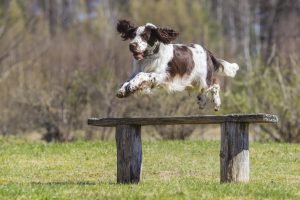Springer Spaniel
Breed description
The Springer Spaniel has been around for centuries, early forms being found as far back as the 1300s. From the same litters of these dogs arose the Cocker Spaniel too, often only being distinguished by their size. That said, after all these years they are now identifiably separate breeds. The Springer has a long, very successful hunting history, traditionally being used to flush out game for the hunter, before retrieving it. Despite its active, highly energetic nature, these dogs make wonderful companions. They are trainable and eager to please, and thrive on human companionship, making them not only fabulous working dogs but family pets too.
Pros
- Trainable
- Very affectionate dogs who are keen to please
- High exercise tolerance
- Suitable for family life when trained appropriately
Cons
- Very energetic
- Can be boisterous
- Susceptible to various health problems
- Need high levels of activity
Suitable for
Whilst the Springer Spaniel is the ideal shooting companion, it has also proven itself a valuable assistance, service and working dog, as well as integrating seamlessly as part of the family. Their trainability and people-pleasing attitude does make them great working dogs, and also improves their ability to adapt to family life. This breed has often boundless energy which must be focussed and contained in the home, so early onset training will help to develop an obedient dog who understands appropriate home behaviour. Their energy can also be well channelled into activities such as agility, a joy for both these bubbly dogs and their owners.
- Ideal for homes with outdoor space
- Active families
- May be too boisterous around very small children
- Working homes
The Springer Spaniel could make a fantastic addition to an active family with older children or teenagers, who enjoy outdoor activity and perhaps would like to get involved in activities such as agility, it could be the perfect companion in this setting.
Breed care advice
Meeting the breed’s activity requirements is a must for any owner of a Springer Spaniel. For working dogs, this is generally not a concern, but, for those who are predominantly family pets, it’s very important to provide a daily exercise routine and stimulating games to entertain these intelligent and very energetic dogs. A minimum of one hour’s outdoor activity is advisable but many dogs will need more than this to really keep them content, it will also help to prevent any frustration behaviours that could arise from insufficient stimulation, such as chewing, barking, stealing and boisterousness within the house. When this is the case, owners will enjoy an active happy dog when out and about, who is very keen to please, and yet, on arriving home, one that is more than content to relax with his or her family.
Their energetic and inquisitive nature can make Springers susceptible to wounds, torn nails and accidents when out working or walking, it’s important to take some time to check them over after any activity so that any problems can be quickly spotted. This includes the tail tip which is frequently damaged in undocked, working breeds. The coat should be brushed through daily, or weekly if it is clipped back, and excessive swimming should be avoided in order to help prevent ear infections. Where a Springer swims regularly, it’s a good idea to use a gentle ear cleaner every one to two weeks, to help keep the ears healthy.
Known health problems
The breed is known to have higher prevalence of some disorders, which owners must consider before taking on a Springer Spaniel. Many individuals have hip or elbow dysplasia, where abnormal joint formation leads to unevenness, incongruency, and later lameness and arthritis. The BVA (British Veterinary Association)/KC (Kennel Club) elbow and hip dysplasia schemes can be used to assess dogs in order to select those most appropriate for breeding.
Cranial cruciate ligament rupture (CCLR) is not uncommon amongst Springer Spaniels, especially working dogs. The cranial cruciate ligament is present inside the stifle (knee) joint and it helps to stabilise the knee. Unfortunately, it can degenerate and partially or completely rupture causing lameness, pain and secondary complications. Most dogs will require restabilising surgery to restore the knee to an appropriately weight bearing state and help minimise future problems like damaged menisci (joint cushions) and arthritis.
- Hip and elbow dysplasia
- Cranial cruciate ligament rupture
- Inflammatory liver disease – liver inflammation can lead to fibrosis and failure over time, a genetic basis is suspected in Springer Spaniels
- Gundog injuries – working dogs are prone to minor injuries like wounds, as well as more serious accidents that can lead to bone fractures or life-threatening injury. They may also suffer from complications of inhaling foreign bodies like grass awns when working in long grasses. Tendon and ligament problems are also seen in working dogs, various types of inflammation, rupture, contracture or degeneration of the ligaments and tendons of the shoulder and forearm may be appreciated. These often need various radiographs and sometimes arthroscopy (where a camera is placed into the joint) to diagnose and may require surgery, physiotherapy or simply rest and anti-inflammatory medication
- Immune mediated haemolytic anaemia – Springers are estimated to be 10-30 times more likely to develop this condition, where the immune system malfunctions and attacks the red blood cells. They may also be at higher risk of Evans Syndrome, where the immune cells also attack the blood platelets leading to reduced clotting as well.
- Eye problems – retinal dysplasia, cataracts and glaucoma can all be inherited in the breed, and may lead to blindness
- Limber tail in undocked, working dogs – a form of muscle fatigue, leading to muscle atrophy, that is particularly associated with cold weather. It causes the tail to hang down vertically, just a little after the tail base. It can be treated with rest and anti-inflammatories but may recur.
Lead author: Yvette Bell MRCVS
